What’s Different About Homepage SEO?
Optimizing your homepage for SEO is different from working on blog posts or product pages. Unlike those pages, your homepage serves as the central hub of your site, and it usually doesn’t focus on just one keyword.
It plays a few key roles by:
- Introducing your brand to new visitors
- Guiding visitors to key sections of your site
- Creating a strong first impression of your business
From an SEO perspective, the primary goal for homepage optimization is usually to rank for branded keywords (like your company name). So people can easily find you in search engine results pages (SERPs).
However, a well-optimized homepage can also rank for non-branded, high-traffic keywords.
For example, Clockify’s homepage ranks for over 8,000 keywords, including non-branded keywords like “time tracker,” "time tracking software," and "timesheet software," which generate plenty of organic traffic.
(And are super relevant to what they offer: time tracking tools.)
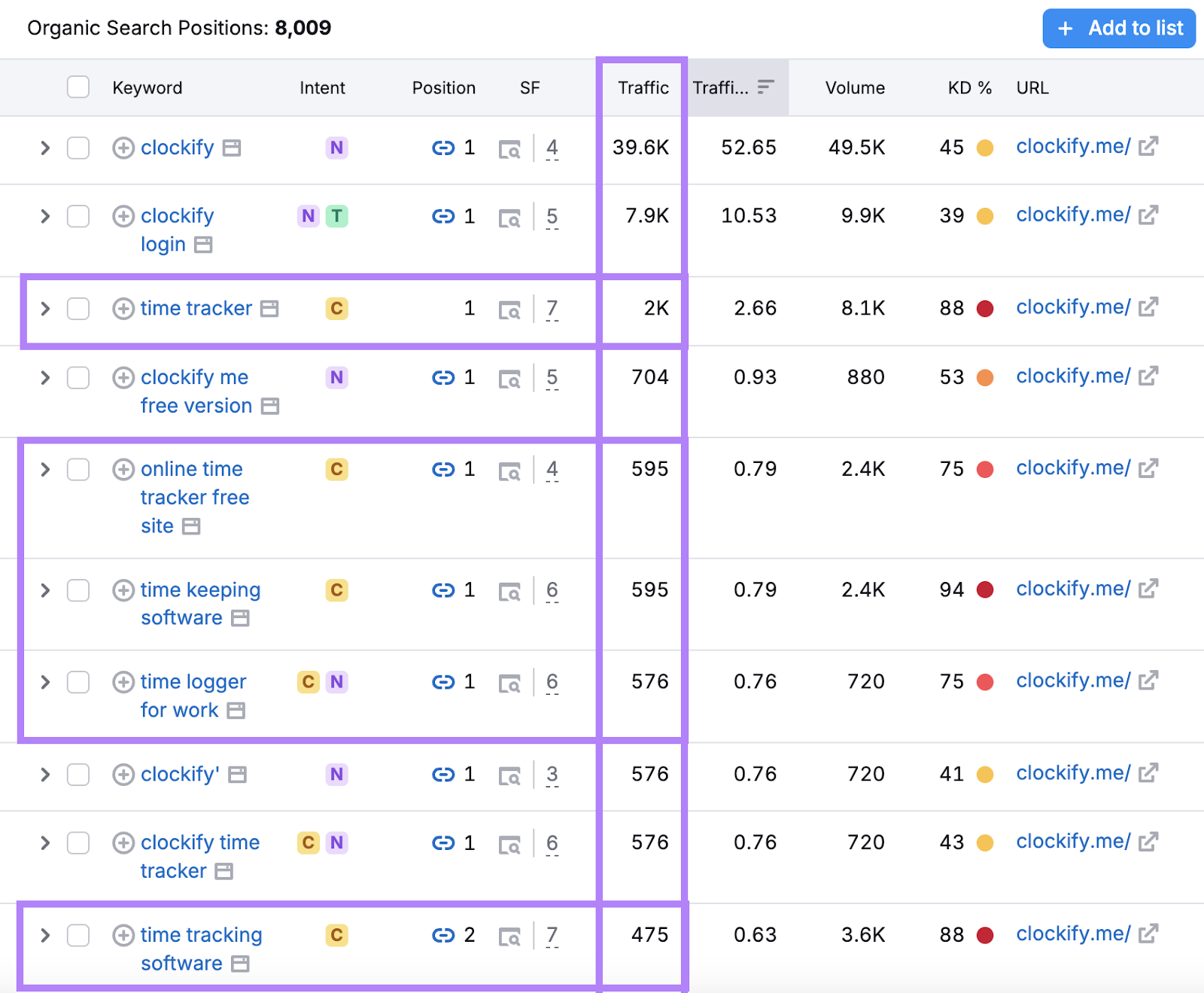
Improving your homepage for SEO doesn’t mean sacrificing user experience (UX), your marketing funnel, or your page design. Good SEO actually makes these better by focusing on what users need and making your homepage easy to use and navigate.
Let’s explore how you can help your homepage rank for more than just branded terms.
How to Optimize Your Homepage for SEO
1. Identify Your Primary Keyword
Your primary keyword is the foundation of your homepage SEO. It should clearly describe your business, match what people are searching for (known as search intent), and help them find what they need.
While this keyword defines the focus of your page, good homepage SEO can also help your homepage rank for dozens—or even hundreds—of related terms.
However, when choosing your primary keyword, keep these key questions in mind:
- Is your homepage already ranking? If it’s already ranking for high-value keywords, optimizing it further may not be necessary. Poor optimization or targeting the wrong keywords could hurt your rankings, rather than help them.
- What does your sales funnel look like? Blogs and content-driven sites often prioritize individual posts over their homepage for traffic and conversions. But SaaS businesses, service providers, and local businesses can benefit from using their homepage as a landing page.
- Are you planning to expand? If you target a narrow, location-specific keyword like “Plumber in Seattle,” your homepage might rank well for that city. However, this could cause problems if you plan to grow your business into new regions or offer additional services in the future.
- What are your competitors doing? Analyze the search results for your target keywords. If most competitors rank their homepages, it might make sense to follow their lead. However, if service pages tend to rank well, you might want to consider focusing on those instead.
Answering these questions can help you develop a clear keyword strategy for your homepage and ensure it aligns with your overall business goals.
Once you’ve considered these factors, start brainstorming keywords that describe your business.
For example, if your business is a tool that helps people build their own websites, potential primary keywords could include “website builder,” “create a site,” or “website building tool.”
Next, check your competitors’ sites to see what keywords they prioritize on their homepage.
For example, Wix, a tool that helps you build websites, uses the term "website builder" on their homepage.
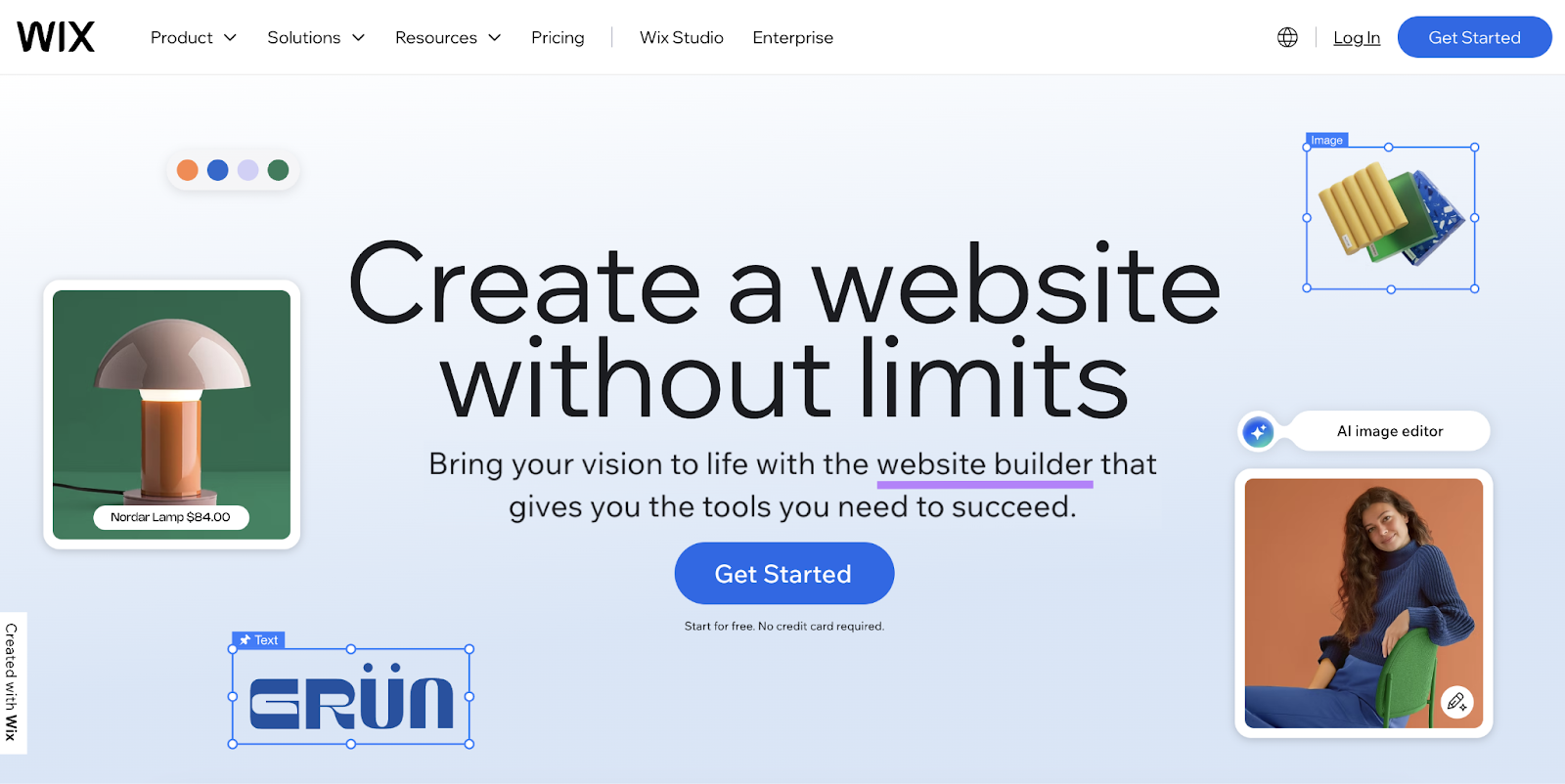
If you search for “website builder” on Google, you’ll notice Wix, Canva, Squarespace, and Weebly all include this keyword in their title tags (more on them soon).
This suggests that "website builder" is a logical primary keyword for a tool that helps people to build their own websites. And it likely means your target audience commonly searches for this keyword.
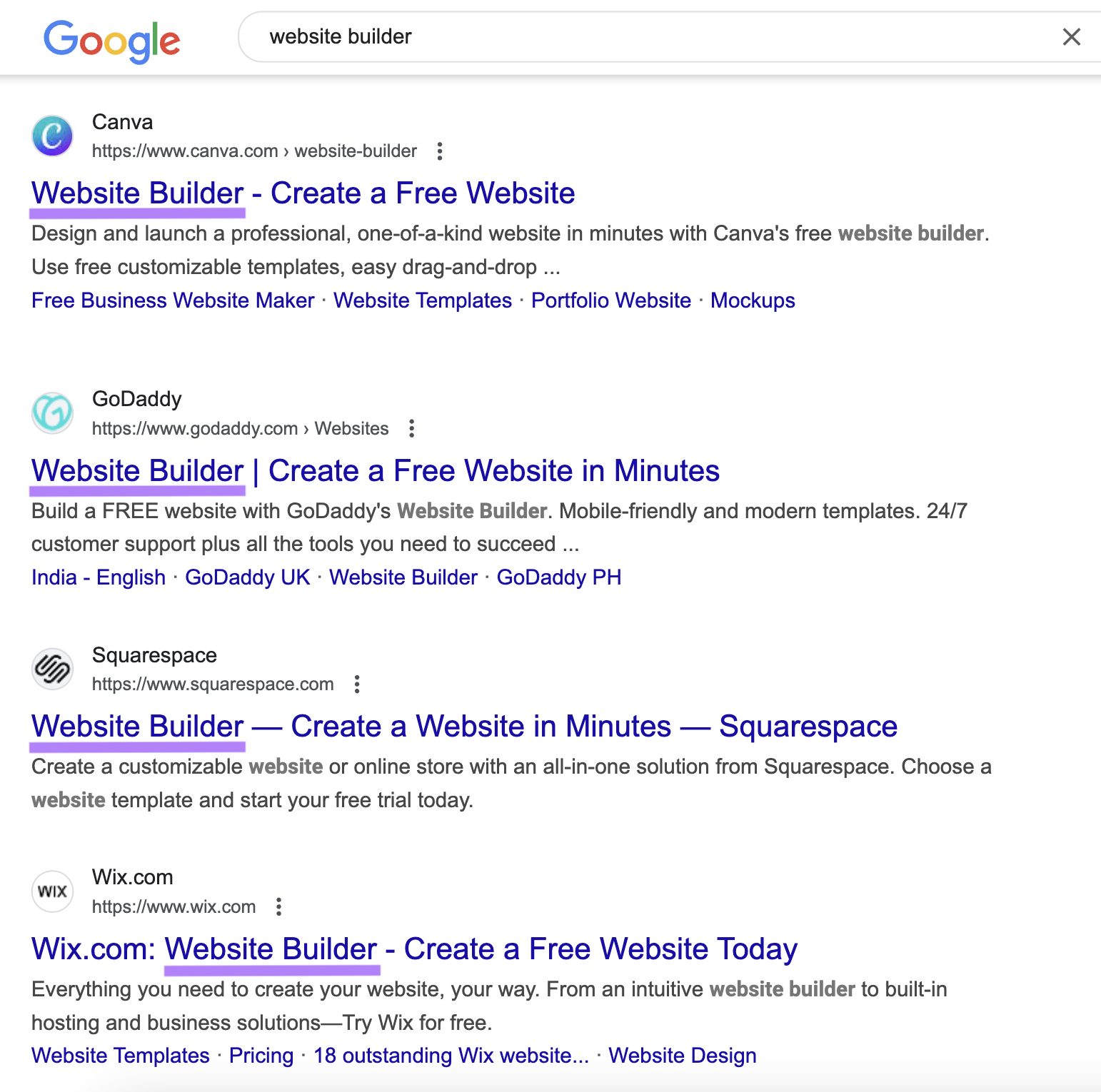
Once you’ve brainstormed some ideas and reviewed competitor’s sites, refine your keyword strategy with Semrush’s Keyword Magic Tool.
It helps you discover related keywords, analyze search volume, and find terms that align with your audience’s needs. So you can target the right keywords on your homepage with confidence.
Start by entering one of your seed keywords into the tool and clicking “Search.”
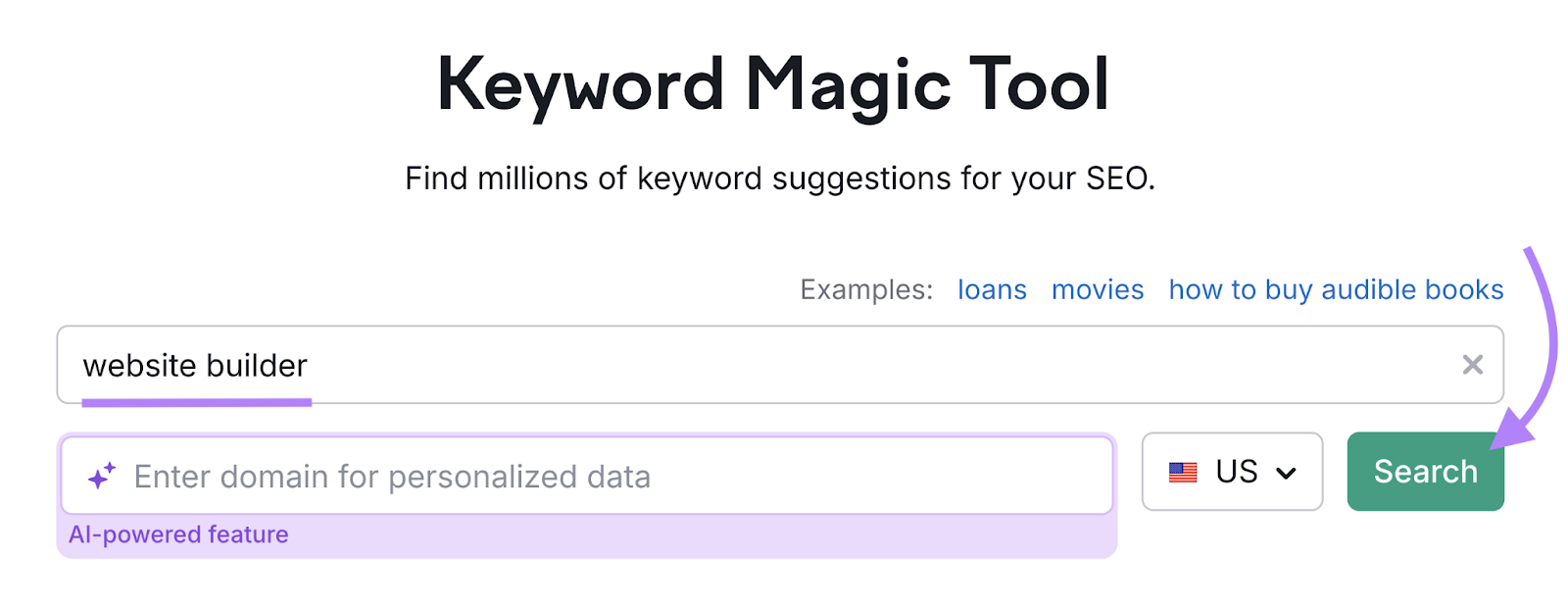
For example, let’s say you enter “website builder” into the search bar.
You’ll see a dashboard with thousands of related keyword suggestions, like this:

Focus on keywords that are relevant to your product, service, or website. And don’t make your primary keyword overly specific (unless it strongly matches your offering).
For example, unless your website builder is specifically for church websites, “best church website builder” likely isn’t the best primary keyword to target.
Once you have a list of potential keywords, select a primary and secondary keyword:
- Primary keyword: Pick the keyword that best describes your homepage and aligns with user intent. Your primary keyword is often the most relevant keyword with the highest search volume.
- Secondary keywords: Choose related phrases that complement your primary keyword. These help your homepage rank for variations and increase its visibility in SERPs, while also providing Google and your users with more context about your website.
Using Semrush’s Keyword Magic Tool, you might find that “website builder” is your best primary keyword, while “free website builder” and “build a website” serve as strong secondary keywords.
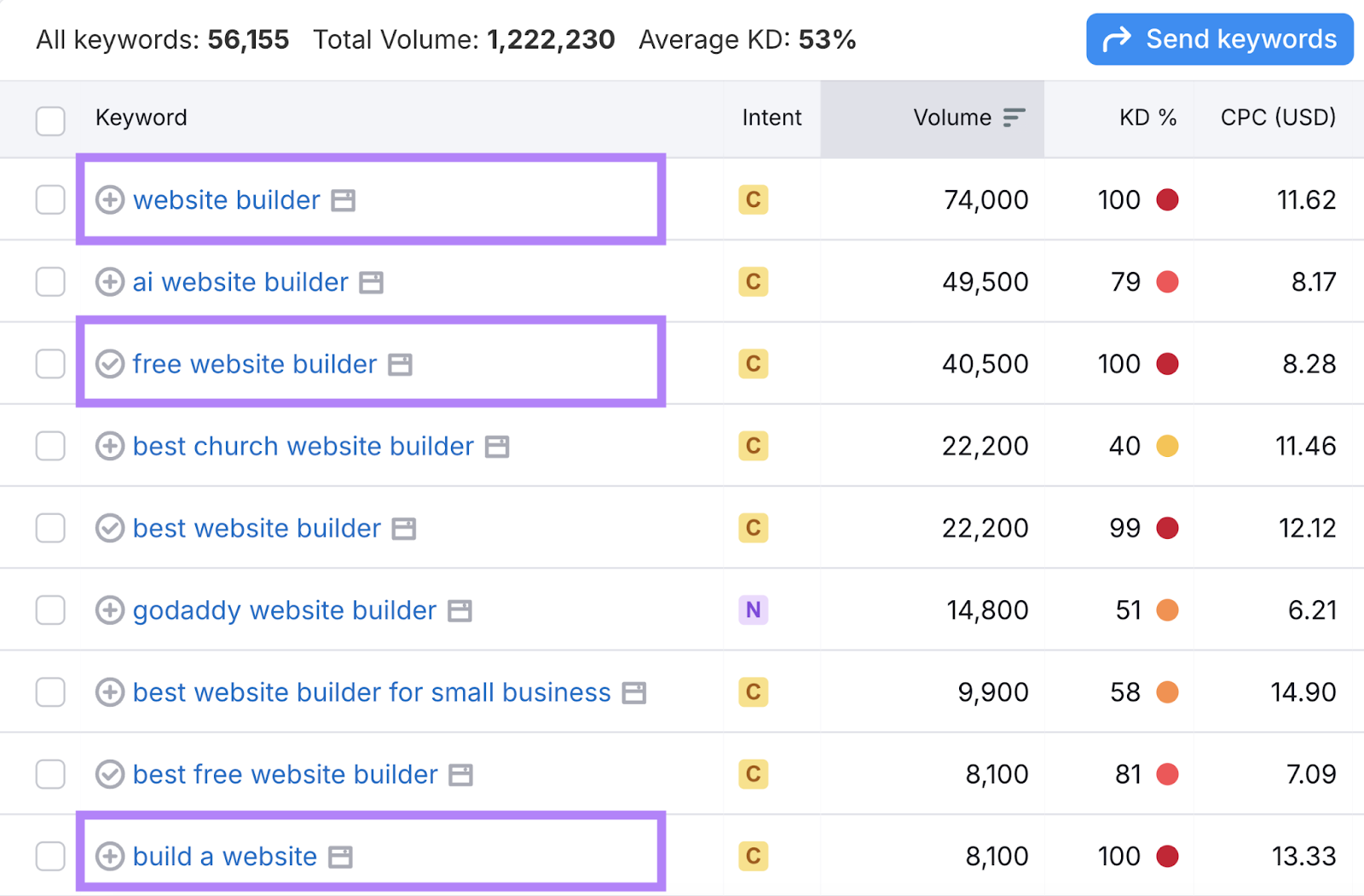
2. Optimize Your Homepage’s Content
After selecting your primary and secondary keywords, the next step is to optimize your homepage content for those keywords. This helps search engines better understand your site and it ensures visitors quickly grasp what your business offers.
Here are the key areas of your homepage to optimize:
Title Tag and Meta Description
Your title tag and meta description are two key elements Google often displays in SERPs. They help search engines understand your page and give users a preview of what to expect.
Your title tag is the clickable headline that can appear in SERPs. It should include your primary keyword and brand name, and it should clearly describe your page.
Your meta description is a short summary that can appear in SERPs below the title tag. It tells users what your page offers. Use some secondary keywords here naturally if possible, and make the description engaging to encourage clicks.
Let’s take a look at an example from Canva. They use their brand name, primary keywords like "website builder," and secondary keywords (like “create a free website” and “free website builder”) in their title tag and meta description to maximize visibility and drive clicks:

Headings and Body Content
Structuring your homepage with headings and organized content helps users navigate and makes it easier for search engines to understand what your page is about.
Headings and body content are defined by HTML tags that create a content hierarchy:
- H1 (main heading): Use a short, clear headline that includes your primary keyword and states what your business does. Use only one <h1> per page.
- H2, H3, H4 (subheadings): Use these to break content into sections and naturally include secondary keywords. H2s introduce sections, while H3 and lower add subsections.
- Body content (<p>): Aim to place your primary keyword in the first 100 words of your body content (ideally sooner). Also use your secondary keywords naturally throughout the text.
Toggl Track’s homepage is a great example of effective headings and content:
- The H1 clearly conveys the product’s purpose (time tracking for teams)
- Subheadings—containing secondary keywords—create scannable sections
- The body text naturally integrates keywords while emphasizing key benefits
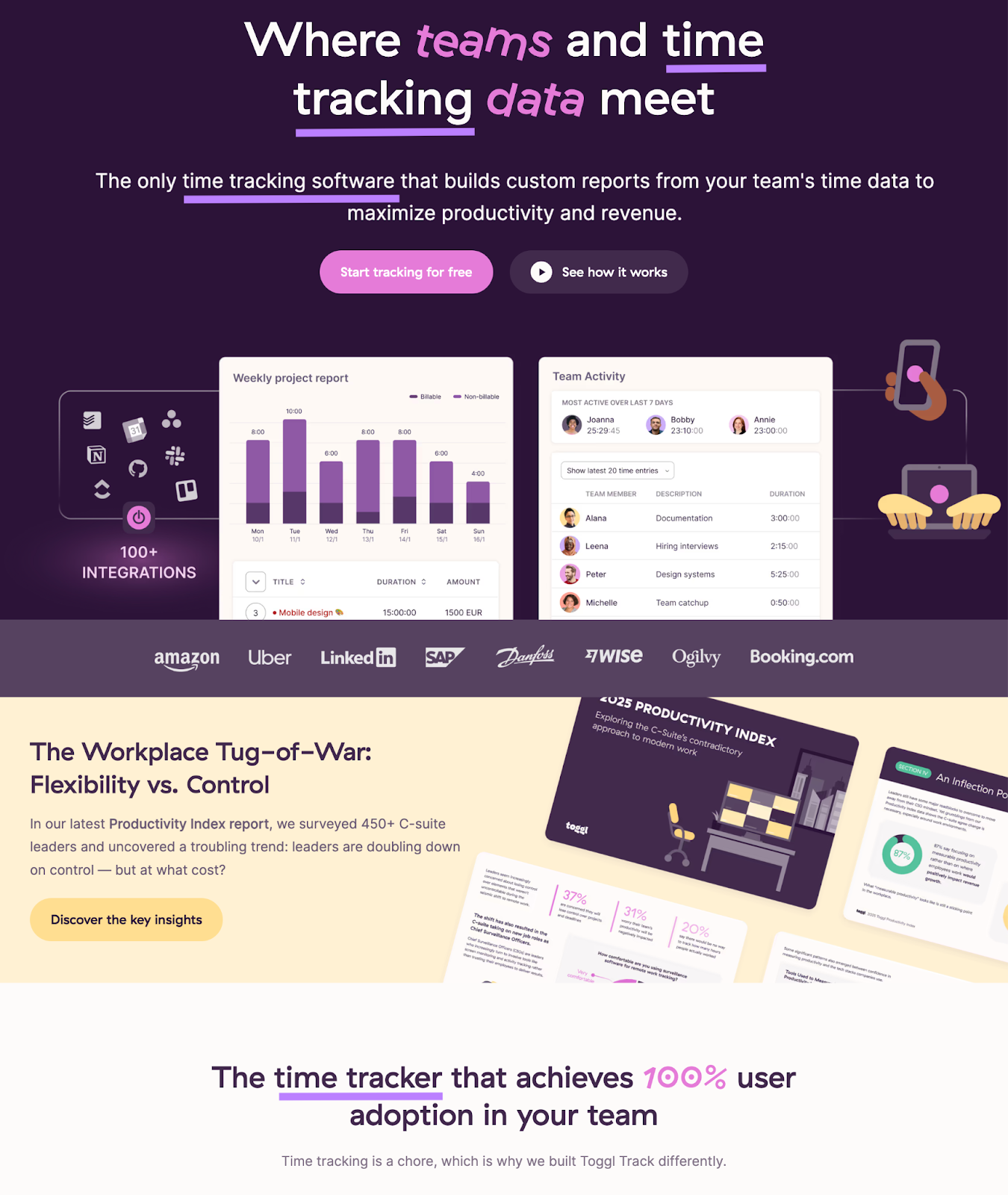
To streamline your content optimization efforts, use Semrush’s On-Page SEO Checker. It offers actionable insights to help improve your homepage content with ease.
After setting up the tool, you’ll land on a dashboard that looks like this:
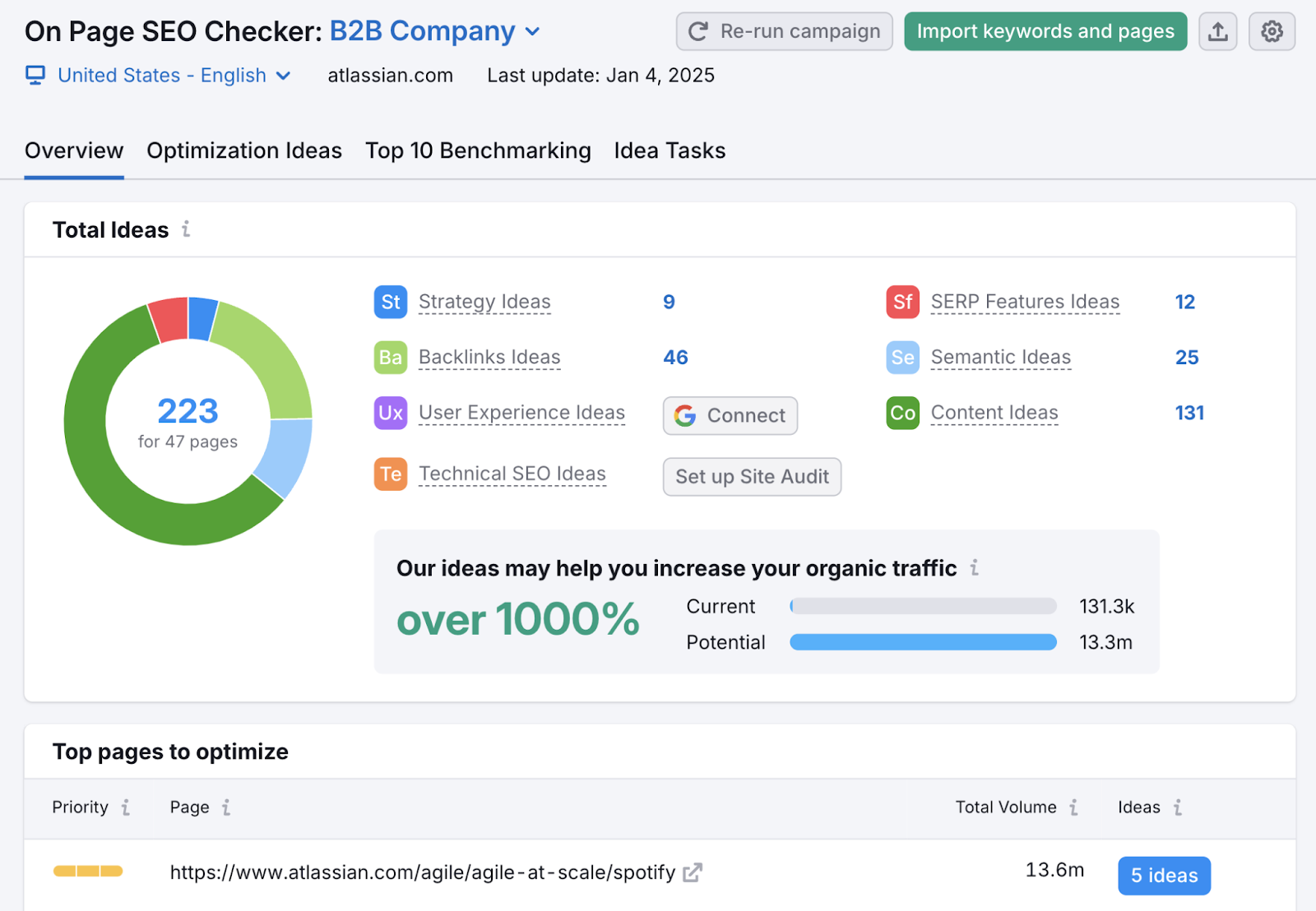
From here, click on pages in the “Top Pages to Optimize” list for specific recommendations. Or head to the “Optimization Ideas” tab for a full overview.
Then click the “# ideas” button next to each page to view detailed suggestions.
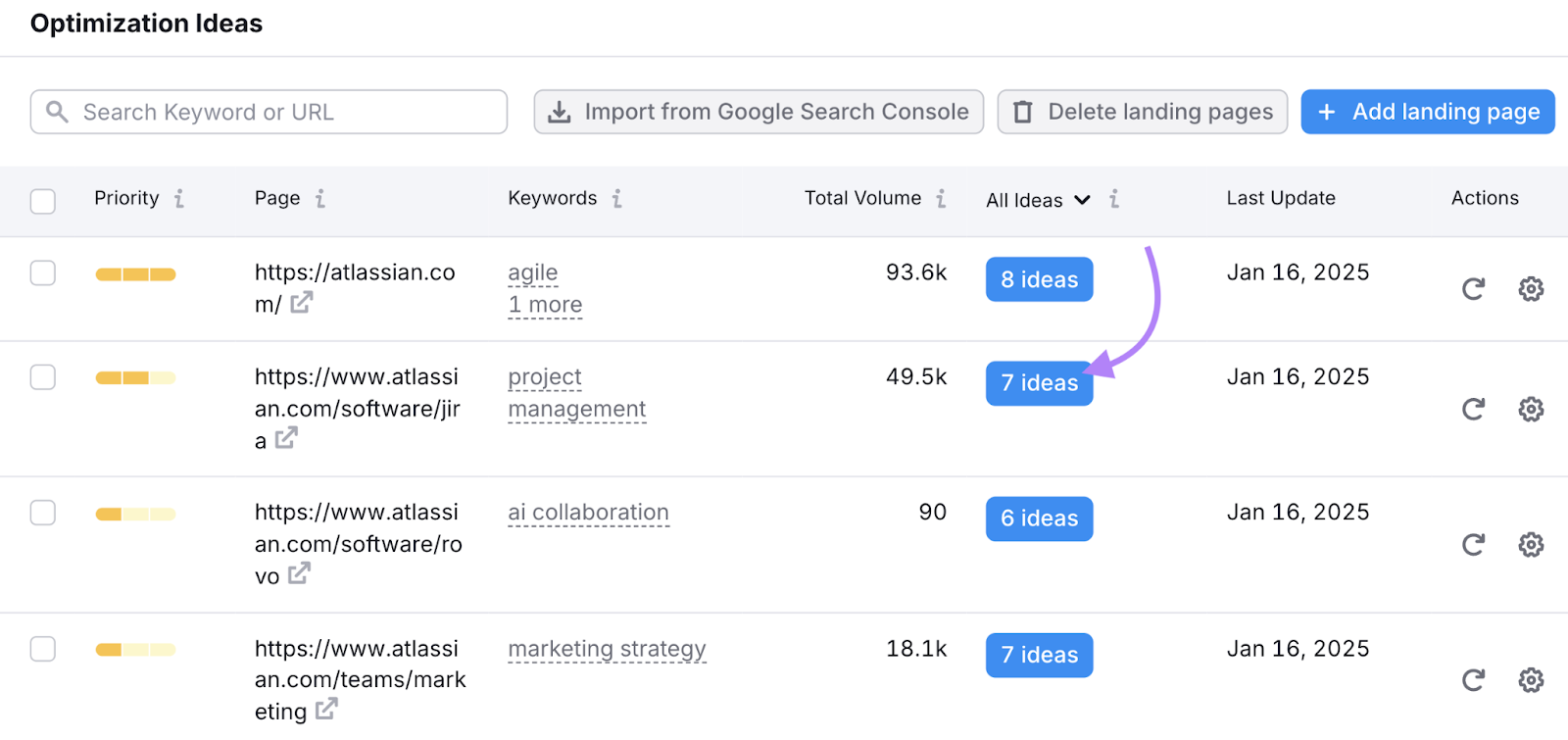
The content section checks if you’ve used your target keywords in important areas like the H1 and body text. The tool also flags keyword stuffing.
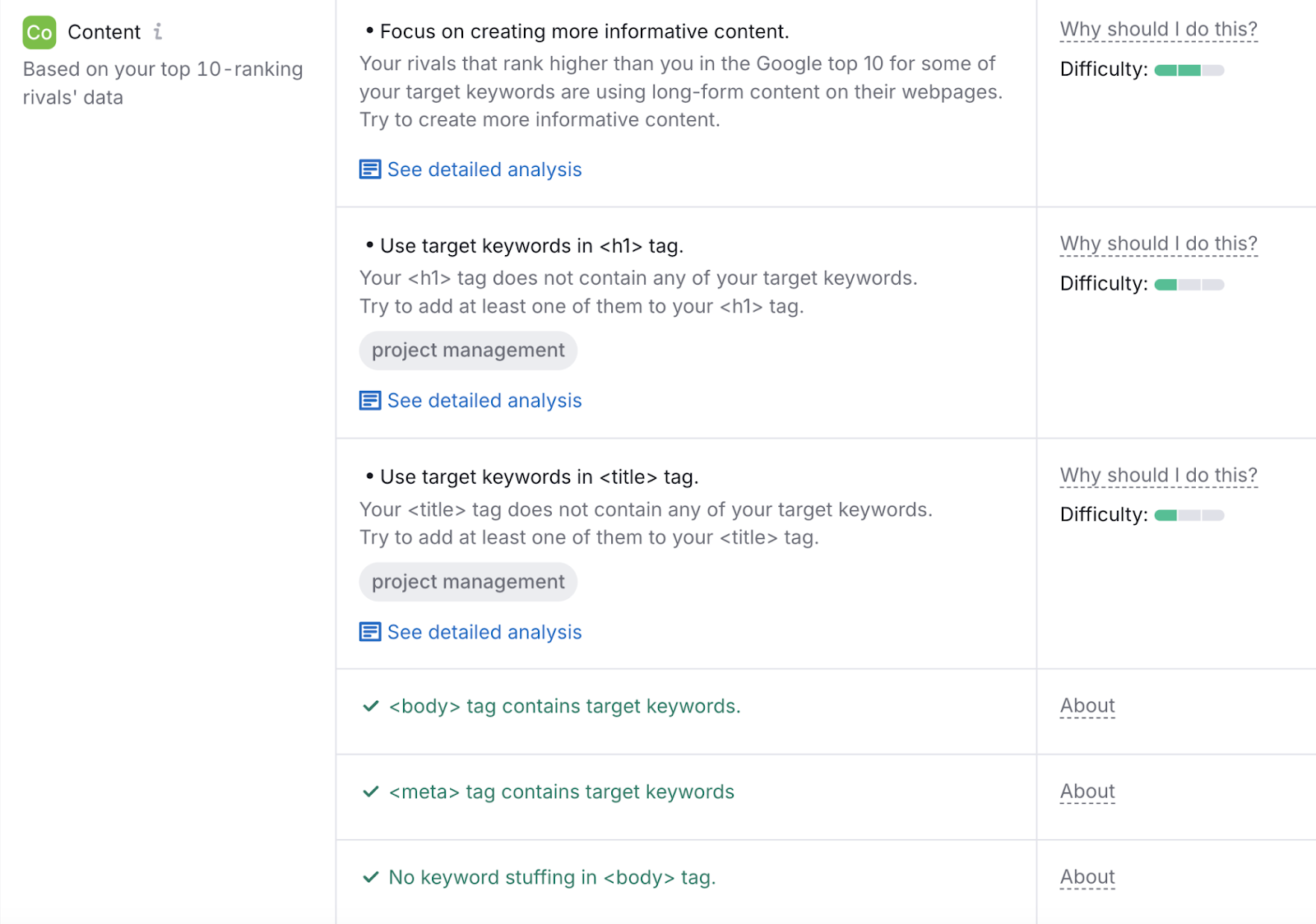
If the tool does detect issues, you’ll receive suggestions like this:
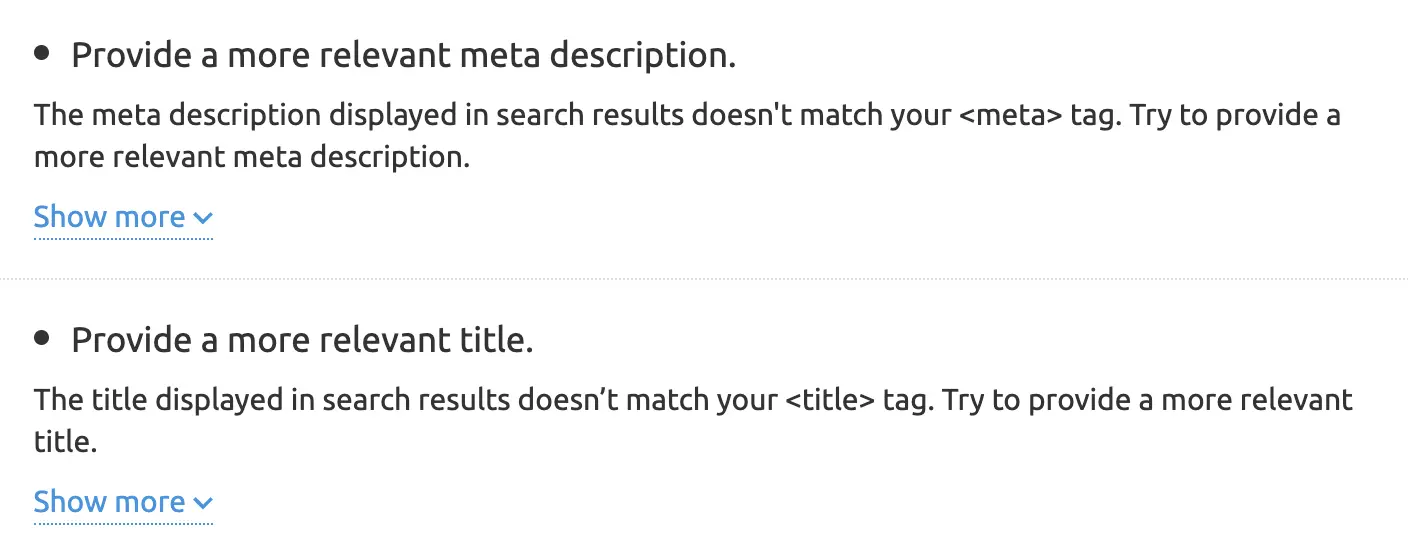
You’ll also receive suggestions for related keywords (also known as semantic keywords) to further optimize your homepage.
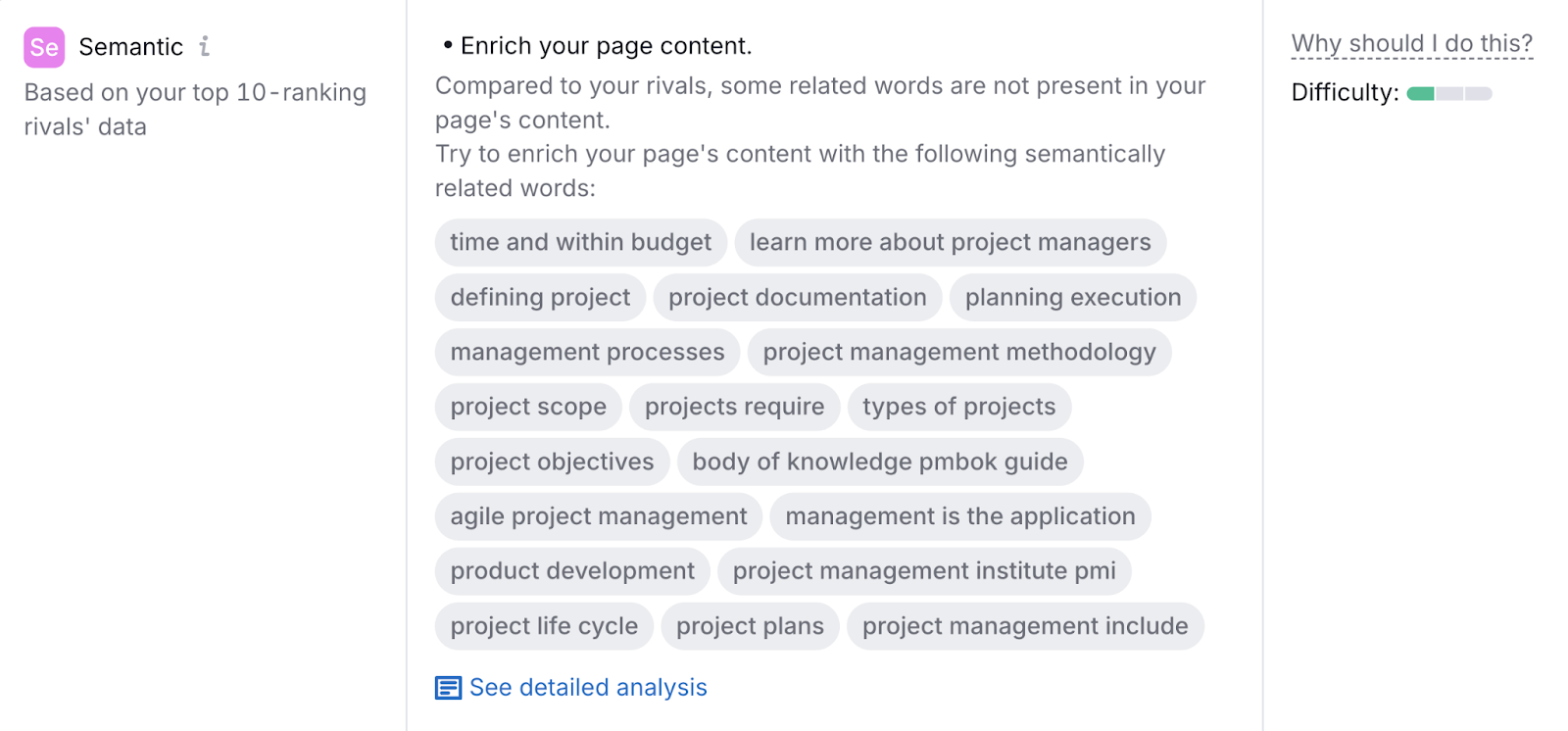
Visuals
Visuals (such as images and videos) can make your homepage more engaging. They can also improve the UX by breaking up text and guiding visitors’ attention. And they can help you show off what you have to offer.
Without visuals, your visitors may feel overwhelmed by blocks of text. And they may overlook key messages or benefits of your product or service.
Here’s how to use visuals effectively:
- Reinforce key messages. Place visuals near important headings or sections to highlight key points and keep users engaged.
- Showcase product benefits. Use screenshots, diagrams, or videos to visually demonstrate how your product works or solves a specific problem.
- Make content scannable. Break up long sections of text with images or infographics to make the information easier to digest.
Here are some real-life examples sites that are doing this well:
Calendly, a SaaS business that provides a calendar and scheduling tool, uses a screenshot of its scheduling interface to show how easy it is to book meetings immediately. Supporting text below the H1 integrates its primary keyword (“scheduling tool”) to reinforce the message.

Basecamp, a project management software, uses product screenshots to highlight how their platform organizes tasks and projects.
Visuals like calendars and project cards show how easy their tool is to use. Plus, they naturally support their primary keyword (“project management system”).
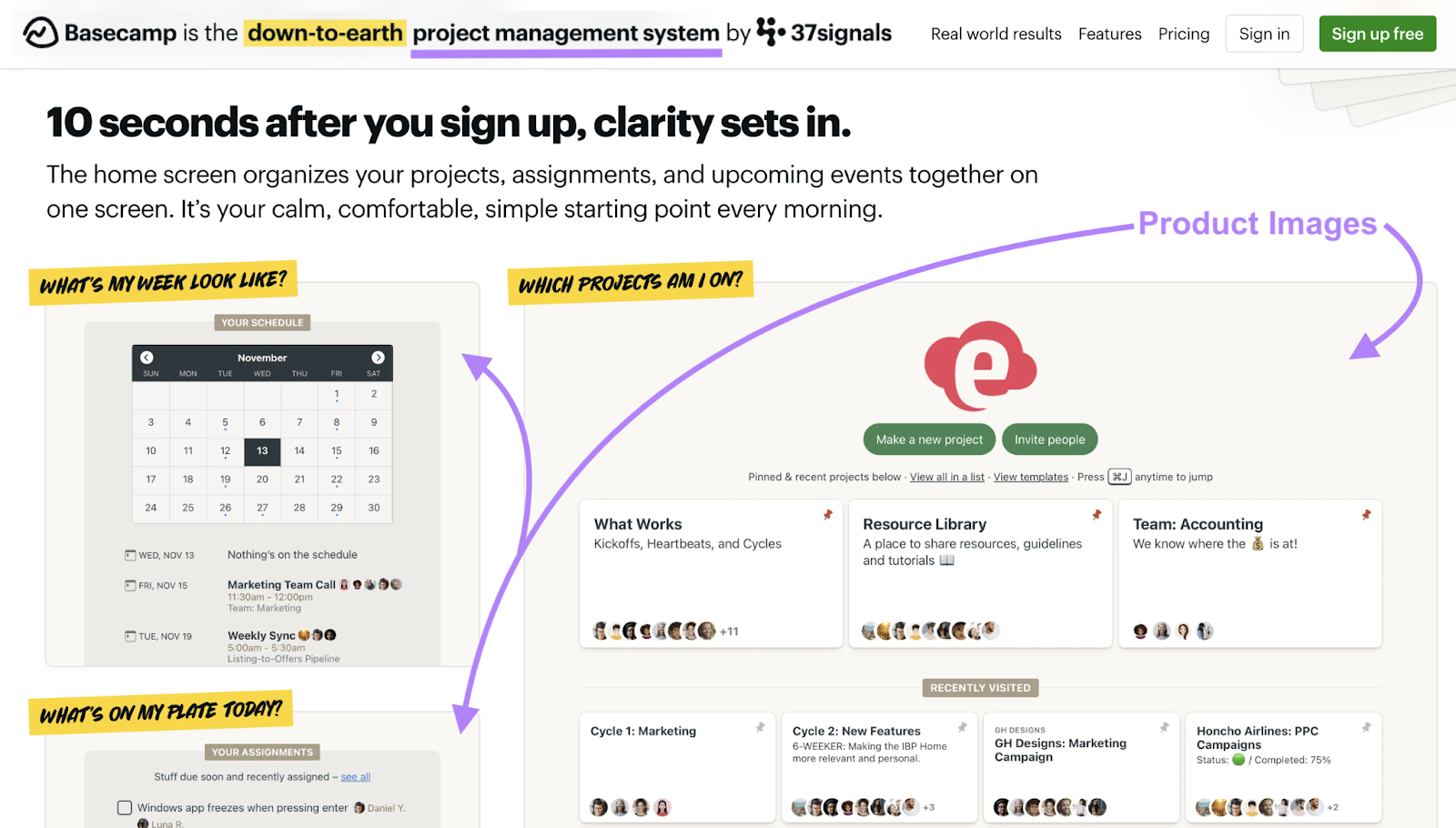
Once your visuals are in place, optimize them for search engines by using descriptive file names and alt text. Use keywords in both to help users and search engines understand the content of your visuals.
Also compress your file sizes. Do this with a tool like TinyPNG or Clideo to maintain quality while improving your page speed.
Further reading: Image SEO: How to Optimize Images for Search Engines & Users
Structured Data
Structured data (also called schema markup) is extra code you can add to your homepage that helps search engines understand your content. Such as your business’s name, address, phone number, website URL, logo, and social media links.
Here’s what it looks like on the backend:
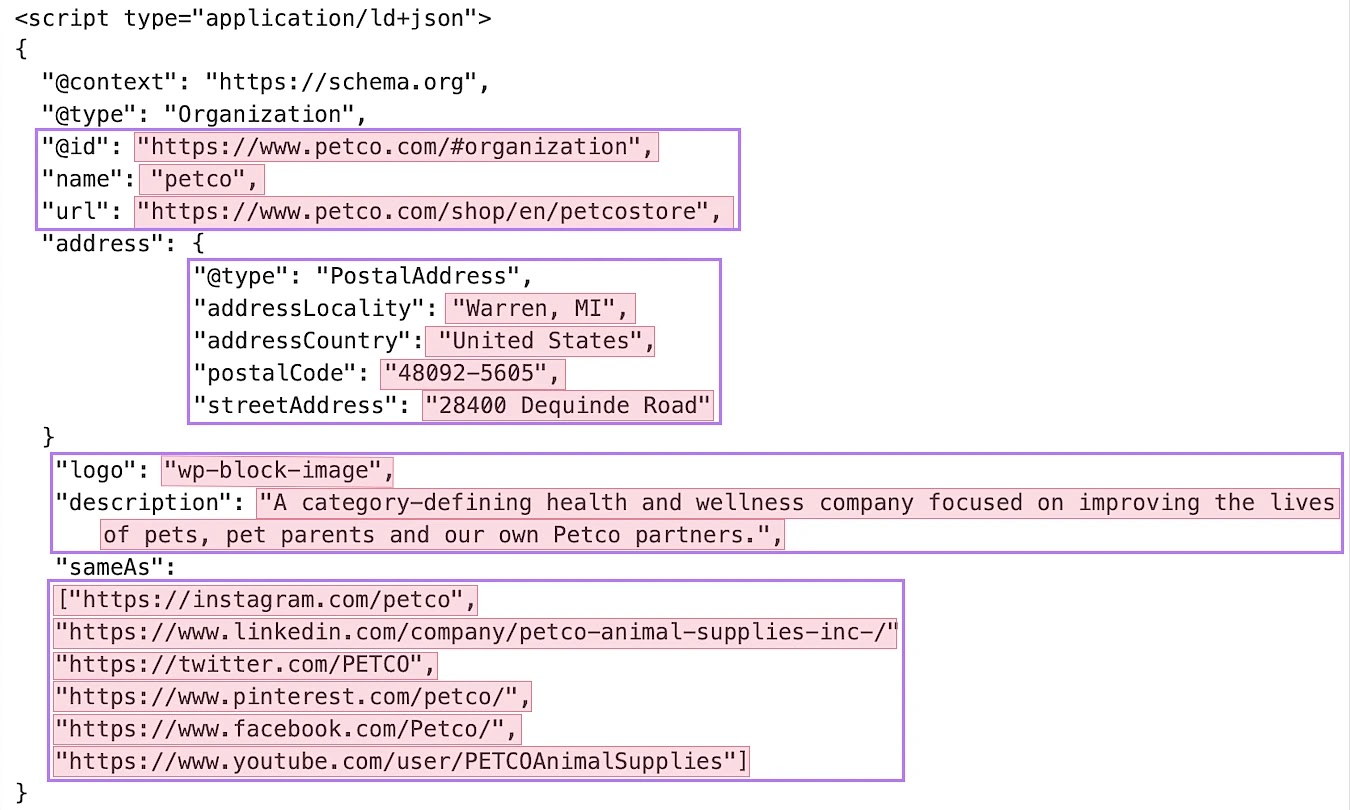
For homepages, organization schema is arguably the most important because it highlights key details about your business.
While users don’t see schema, it helps search engines get additional context about your business. It can then use this information to help it understand what to display in search results.
If your business has a knowledge panel (a box that appears in Google search results showing key facts about your business), adding schema can help refine the information shown.
Like this:
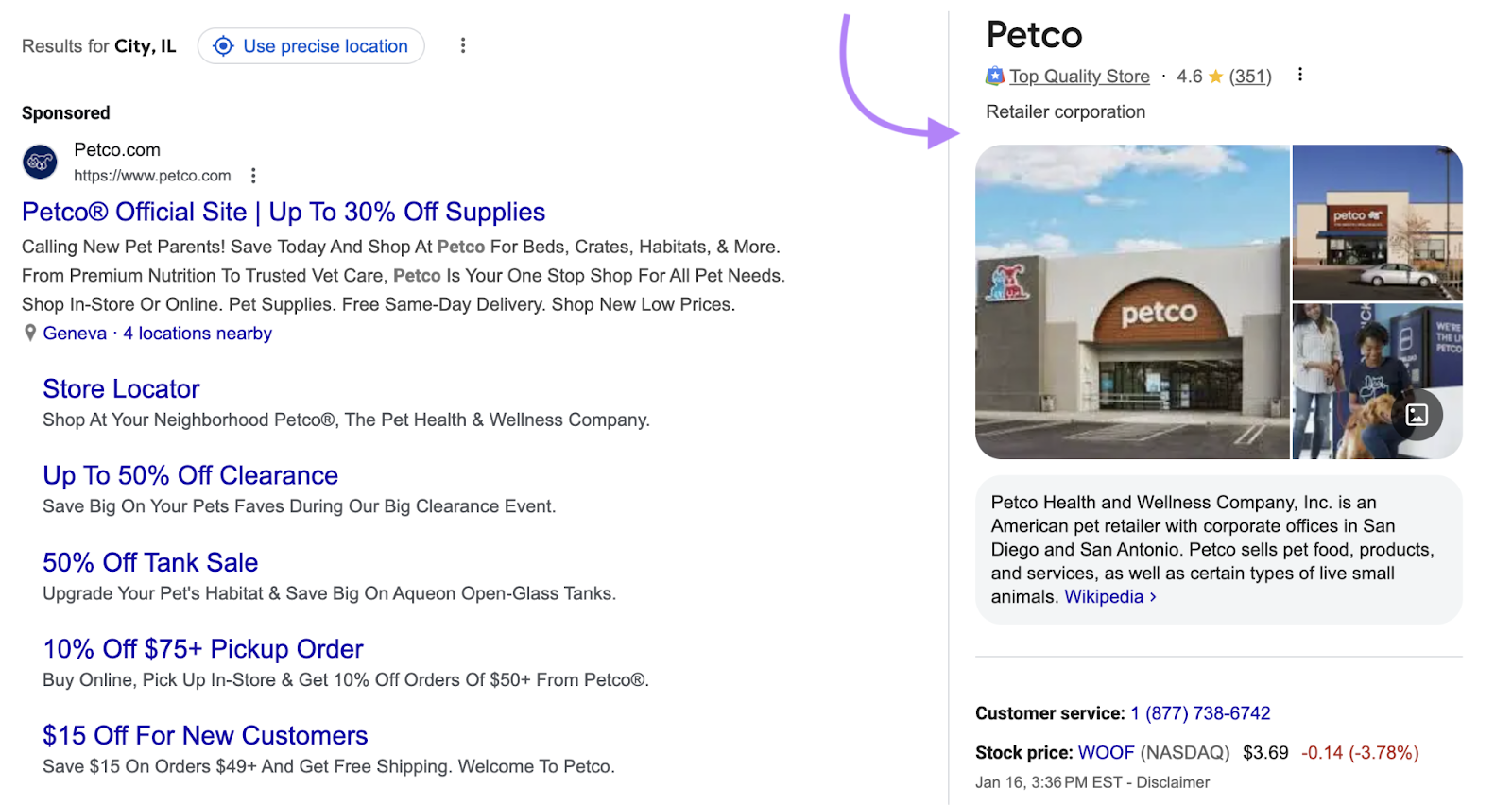
3. Create a Great User Experience (UX)
Creating a great UX keeps visitors engaged and encourages them to explore your site further. Here are some areas to focus on to create a great UX for site visitors.
Site Navigation
Site navigation, or site architecture, refers to how your website's pages are structured and interconnected. Think of it as your site’s blueprint, guiding visitors to the content they need while also helping search engines understand your site.
And your header navigation—the main menu at the top of your site—is crucial for creating a seamless user experience.
It should:
- Avoid overwhelming visitors with too many options
- Provide a simple and logical path to your most important pages
- Use clear, descriptive labels so visitors know where each link leads
For larger sites, drop-down menus can group related content into categories and subcategories, making navigation easier.
For example, Gymshark’s header navigation includes a drop-down menu for “Accessories” with clear categories like “Trending,” “Footwear,” “Bags,” and “Equipment.”
This well-structured menu allows visitors to quickly locate what they need, enhancing the overall user experience. Plus, anything that makes it faster and easier for users to find what they are looking to buy is good for the business too.
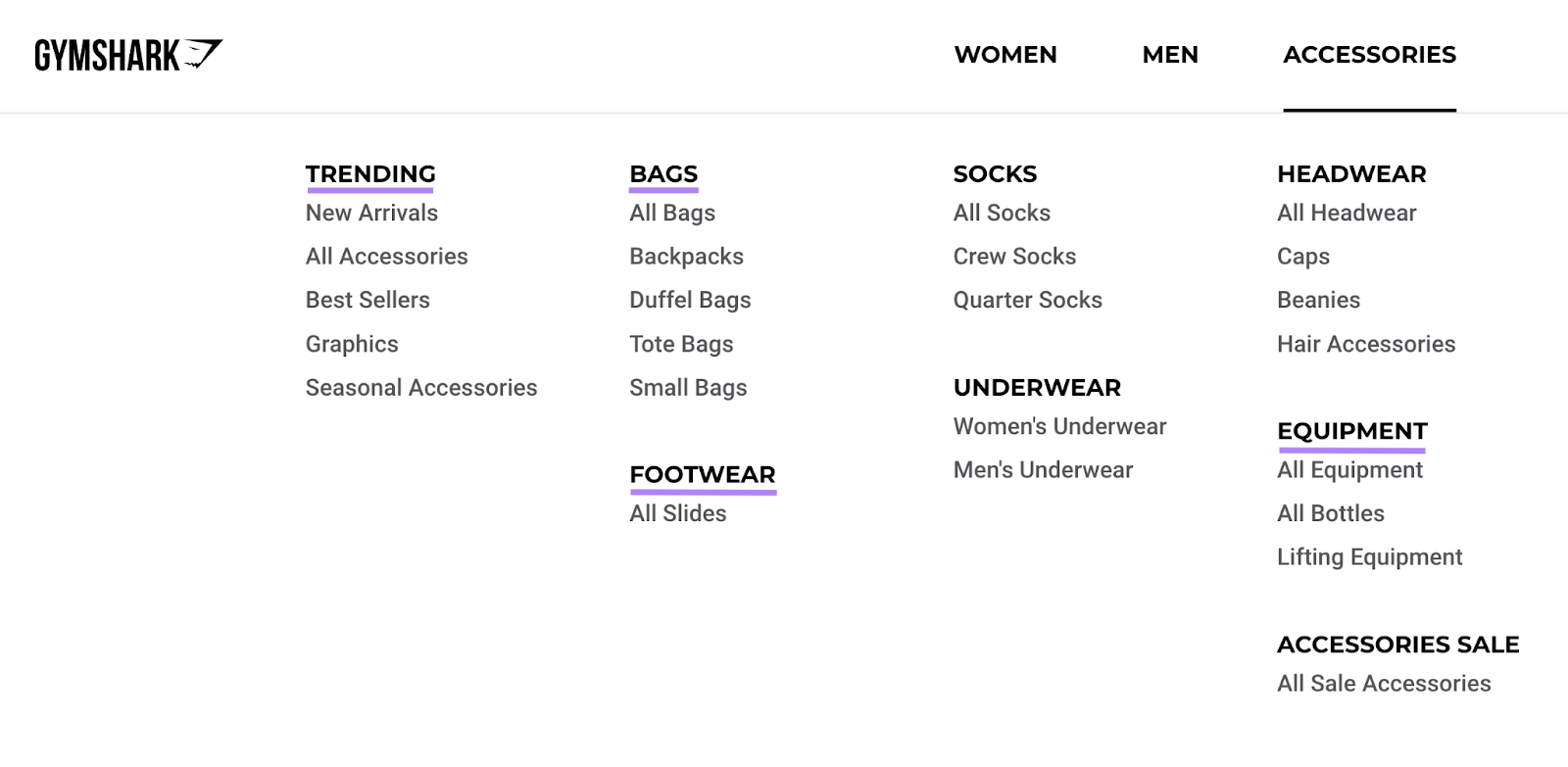
Footer navigation, located at the bottom of your site, acts as a central hub for secondary information. It’s an ideal space for links that aren’t part of your main menu but are still valuable to users.
Common footer links include company policies (like privacy, cookies, and terms and conditions), contact information, press details, and pages like “About Us” and “Careers.”
Gymshark’s footer organizes links into sections like “Help,” “My Account,” and “Pages.” It also includes quick access to customer support, account management, and social media links, ensuring visitors can easily find the information they need.
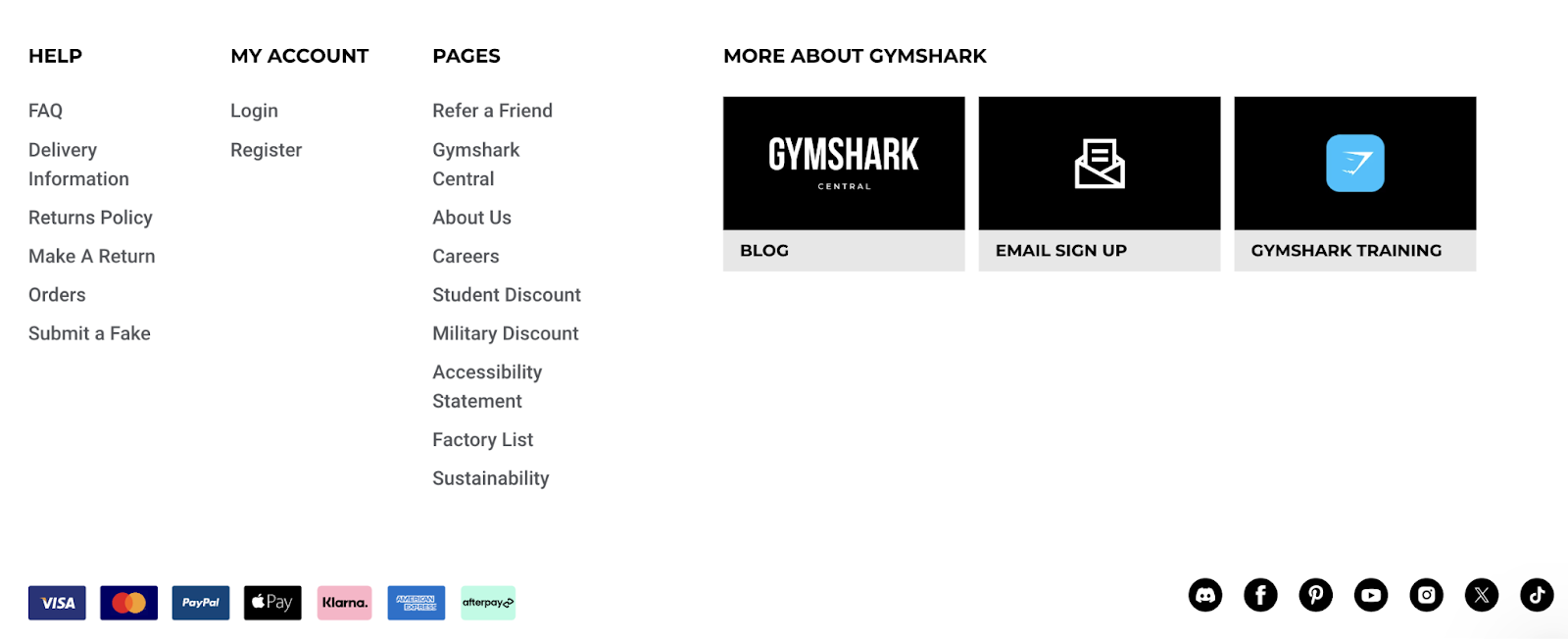
Note: Your header menu and footer are typically present across your entire website—not just your homepage. But optimizing them as part of your homepage SEO still makes sense, given your homepage will serve as the entry point for a lot of your site’s visitors.
Page Speed
A slow homepage can frustrate visitors, increase bounce rates, and hurt your rankings. So you’ll want to focus on site performance when optimizing your homepage’s SEO.
Google uses Core Web Vitals (CWV) to measure how well your site performs.
These metrics check three things:
- Loading speed: How fast the largest element of your page (often an image or block of text) appears (Largest Contentful Paint)
- Interactivity: How fast your site responds when users click, scroll, or type (Interaction to Next Paint)
- Visual stability: Whether the page layout stays steady while loading, avoiding sudden shifts that can frustrate visitors (Cumulative Layout Shift)
In simple terms, CWVs check if your website is fast, responsive, and stable, ensuring a smooth experience for visitors. And Google favors fast sites, so improving page speed and your CWV is crucial.
Here are three easy ways to improve your homepage’s loading speed and meet CWV standards:
- Compress your images: Use tools like TinyPNG to compress image files without losing quality. Also use modern formats like WebP for faster loading times.
- Minimize code: Remove unused code and scripts that slow down your site. And reduce the size of CSS, JavaScript, and HTML files.
- Use a Content Delivery Network (CDN): CDNs speed up load times by distributing your website’s content across servers worldwide. This ensures quick access for users in different locations.
Mobile Experience
Google predominantly uses the mobile versions of websites to determine ranking (known as mobile-first indexing). So, optimizing your site for mobile is essential for both user experience and your rankings.
Here’s how to optimize your homepage for mobile users:
- Responsive design: Ensure your homepage automatically adjusts to different screen sizes and orientations with responsive web design
- Simplify navigation: Use a hamburger menu for compact, clear navigation. Make sure buttons and links are large enough to tap easily on a touchscreen.
- Optimize mobile load times: Focus on improving page speed for mobile users by compressing images and avoiding heavy graphics or animations
- Avoid intrusive pop-ups: Minimize or eliminate pop-ups that cover the screen, as they frustrate users and can negatively impact your rankings
Further reading: The Complete Guide to Mobile SEO: 8 Tips & Best Practices
4. Showcase EEAT
E-E-A-T (Experience, Expertise, Authoritativeness, and Trustworthiness) is a framework Google uses to evaluate the quality of site content. It’s a concept rooted in Google’s Search Quality Rater Guidelines, a handbook that guides how Google’s reviewers assess the quality of search results.
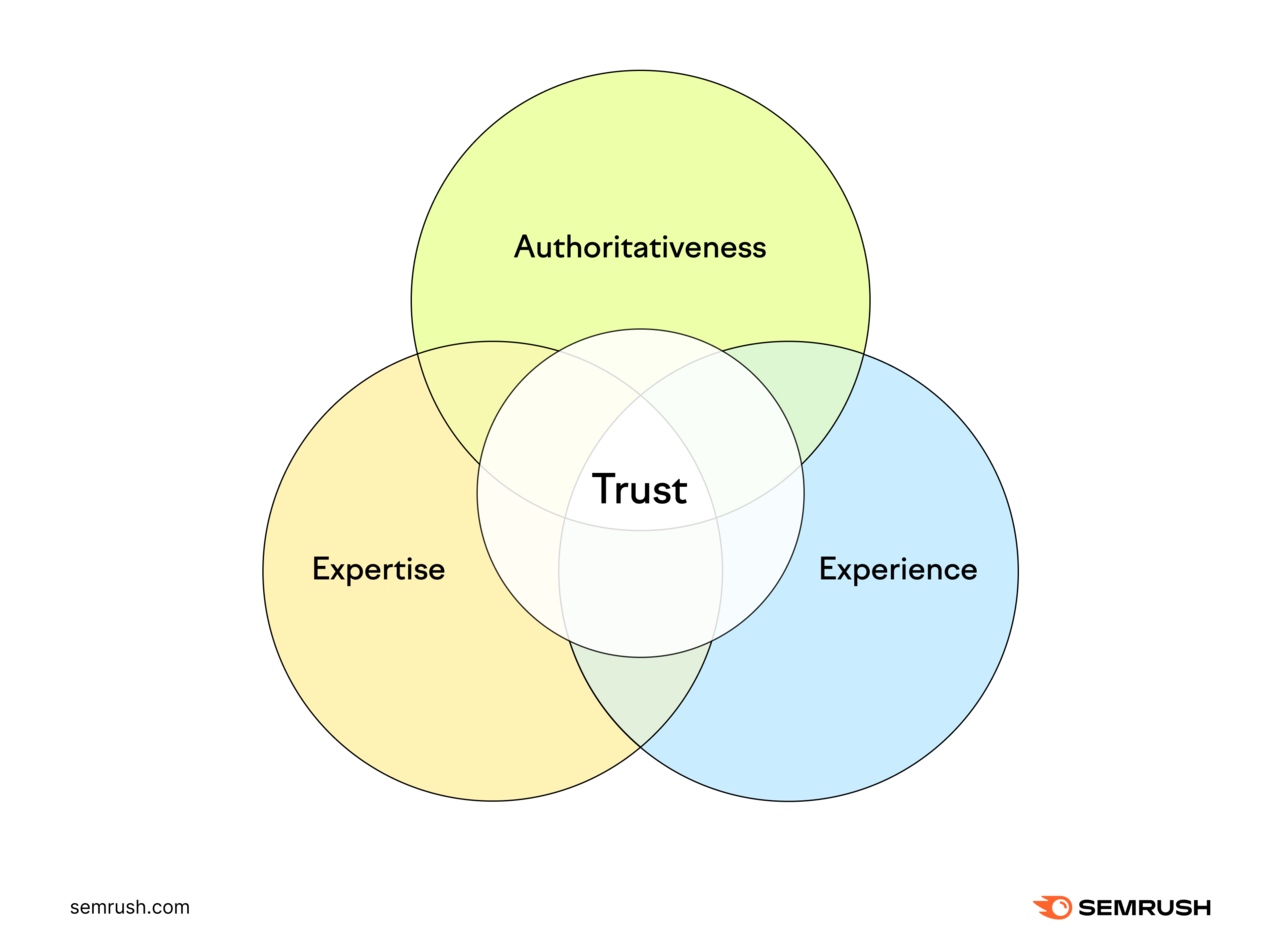
.
While not a direct ranking factor, demonstrating strong E-E-A-T can help you build trust with your audience and increase your content’s credibility and relevance. This in turn can lead to more conversions for your business.
Here’s how to ensure your homepage builds trust:
- Convey your purpose clearly. Your homepage should immediately communicate its purpose—whether it’s introducing your business, guiding users toward specific pages, or showcasing your products and services.
- Provide key information. Prominently display your business name, contact details, and an overview of your services or products.
- Show credibility through validation. Include third-party validation like reviews, awards, or certifications. Feature testimonials, case studies, or videos that demonstrate your expertise and build trust.
- Simplify user experience. Avoid overwhelming users with irrelevant information. Focus on meeting their immediate needs quickly and clearly.
- Avoid deceptive practices. Don’t use clickbait, overpromise features, or include misleading content. Ensure your page delivers exactly what users expect based on your headlines and descriptions.
5. Add Internal Links to and From Your Homepage
Internal links connect different pages within your site. They help users navigate your site and make it easier for search engines to understand your site’s structure.
Your homepage plays a vital role as the central hub of your website, guiding users to key sections and distributing page authority through relevant internal links.
Here are two key ways to use internal linking to improve your homepage SEO:
- Guide users to key pages. Link prominently to essential pages like “About Us,” “Services,” “Products,” and “Contact Us.”
- Feature high-value content. Use sections on your homepage to highlight products/services, case studies, or blog posts.
For example, Petco’s homepage includes a “Top Sellers” section that directs users to some of its most popular and high-value product pages:
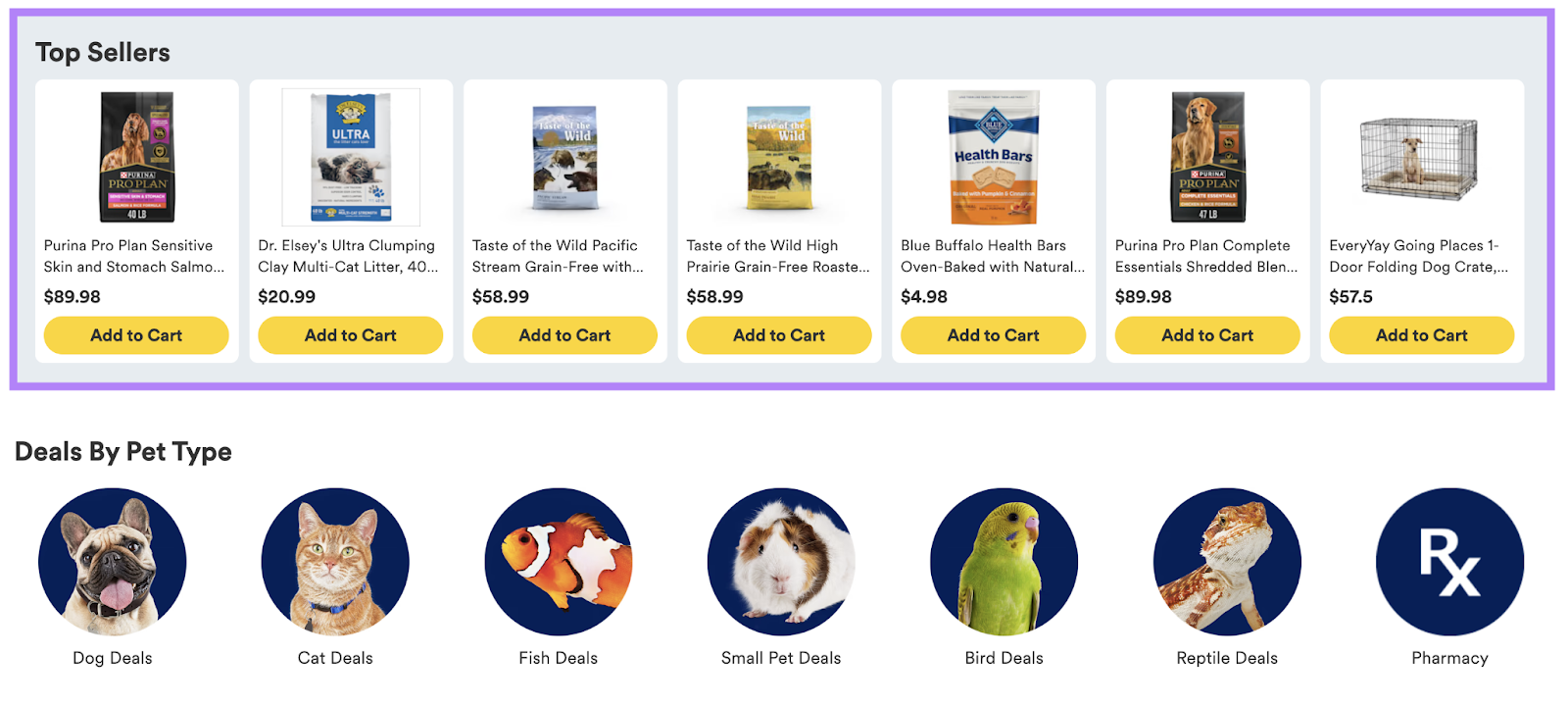
Petco also highlights top categories for dogs and cats. This makes it easy for visitors to explore relevant product pages tailored to their needs:

Adding key sections like this helps visitors quickly find what they’re looking for, while allowing Petco to showcase its most important products.
This approach enhances the user experience by guiding visitors to the right pages. It also helps search engines better understand and prioritize key pages on your site.
6. Earn Backlinks to Your Homepage
Backlinks are links from other sites to your site. When authoritative sites link to your homepage (or any other page), it signals to search engines that your site is trustworthy and valuable.
Having a high number of quality backlinks can:
- Drive referral traffic from users clicking those links
- Help search engines discover your content more effectively
- Improve your rankings by increasing your site’s authority
For example, the homepage of nytimes.com has over 2.1 million backlinks. Including ones from reputable sites like bbc.co.uk and microsoft.com.
This helps contribute to its high “Page” Authority Score (84).
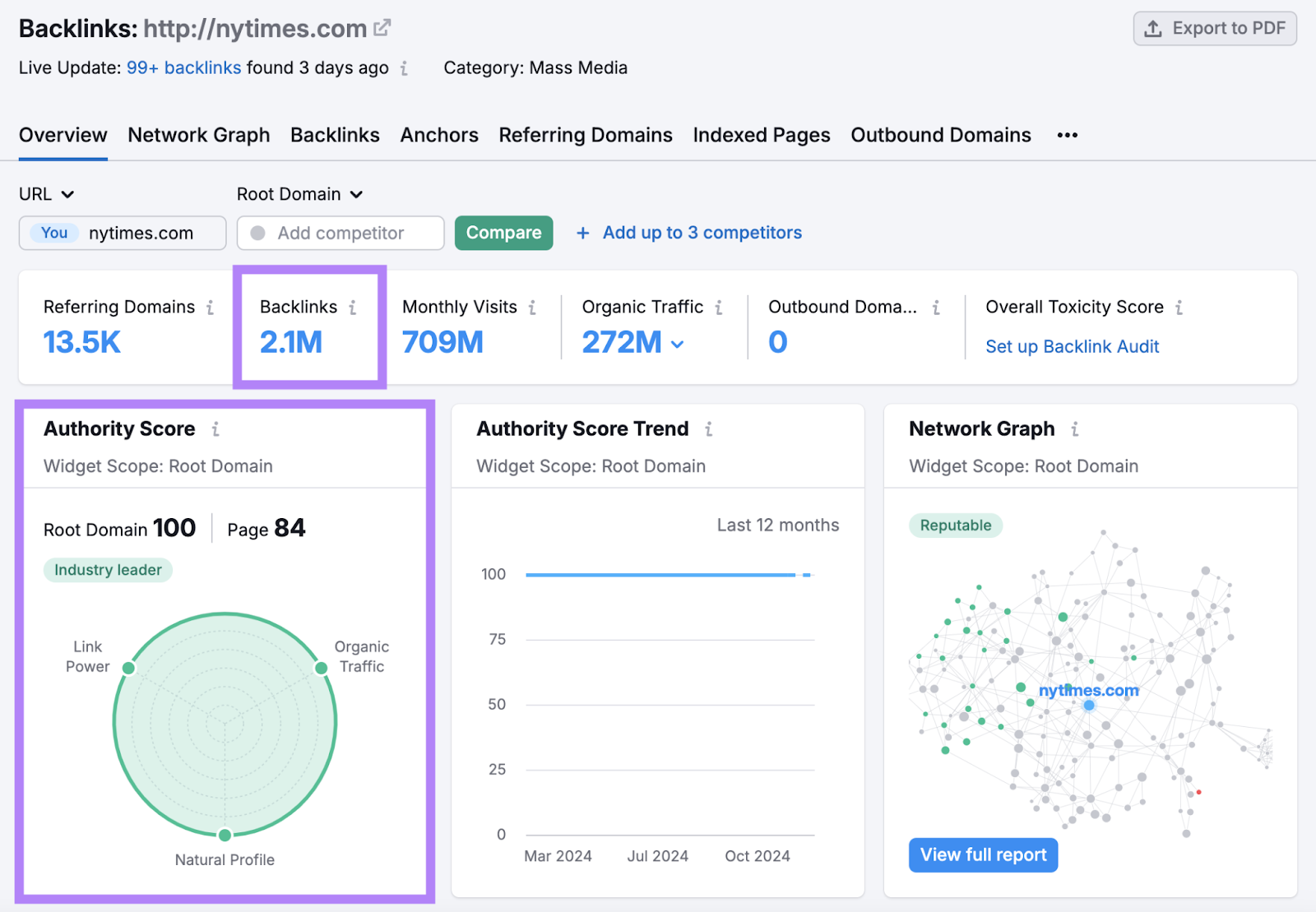
Plus, nytimes.com receives 20.4 million visits from referral traffic (across all backlinks to the site—not just the homepage).

Here are proven methods to earn high-quality backlinks:
- Engage in digital PR. Create digital PR campaigns to get featured in industry news, blogs, or podcasts to gain backlinks.
- Collaborate with influencers and industry experts. Work with influencers to promote your brand and ask them to link to your homepage in their content.
- Leverage business relationships. Request backlinks from partners, vendors, or clients who might highlight your brand on their sites.
- Fix broken backlinks. Identify broken links pointing to your homepage and ask site owners to replace them with an updated URL.
For more info on how to build high-quality backlinks to your site, check out the following guides:
7. Fix Any Technical SEO Issues
Fixing technical SEO issues ensures your site runs smoothly for both search engines and users.
Search engines use crawlers to explore your site and ultimately determine if they should index and rank your content. So, technical issues can make it hard (or impossible) for Google to find and ultimately display your website in search results. Making fixing these issues a major priority.
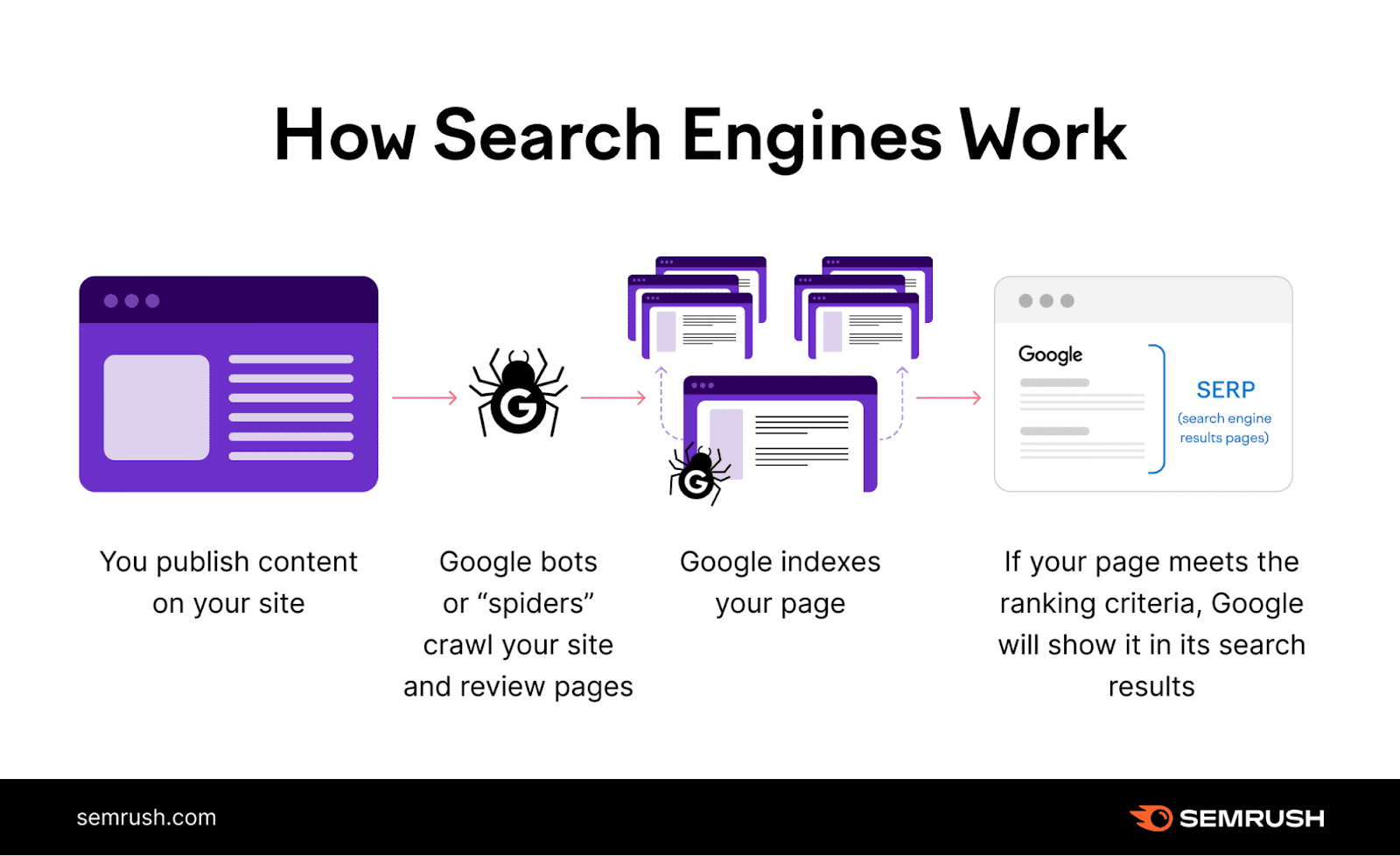
Semrush’s Site Audit tool helps you identify and resolve technical SEO issues.
Once the tool crawls your site, it provides a “Site Health” score that ranges from 0 to 100, offering a clear grade of your site’s overall technical health. It also compares your site’s performance with others in your industry.
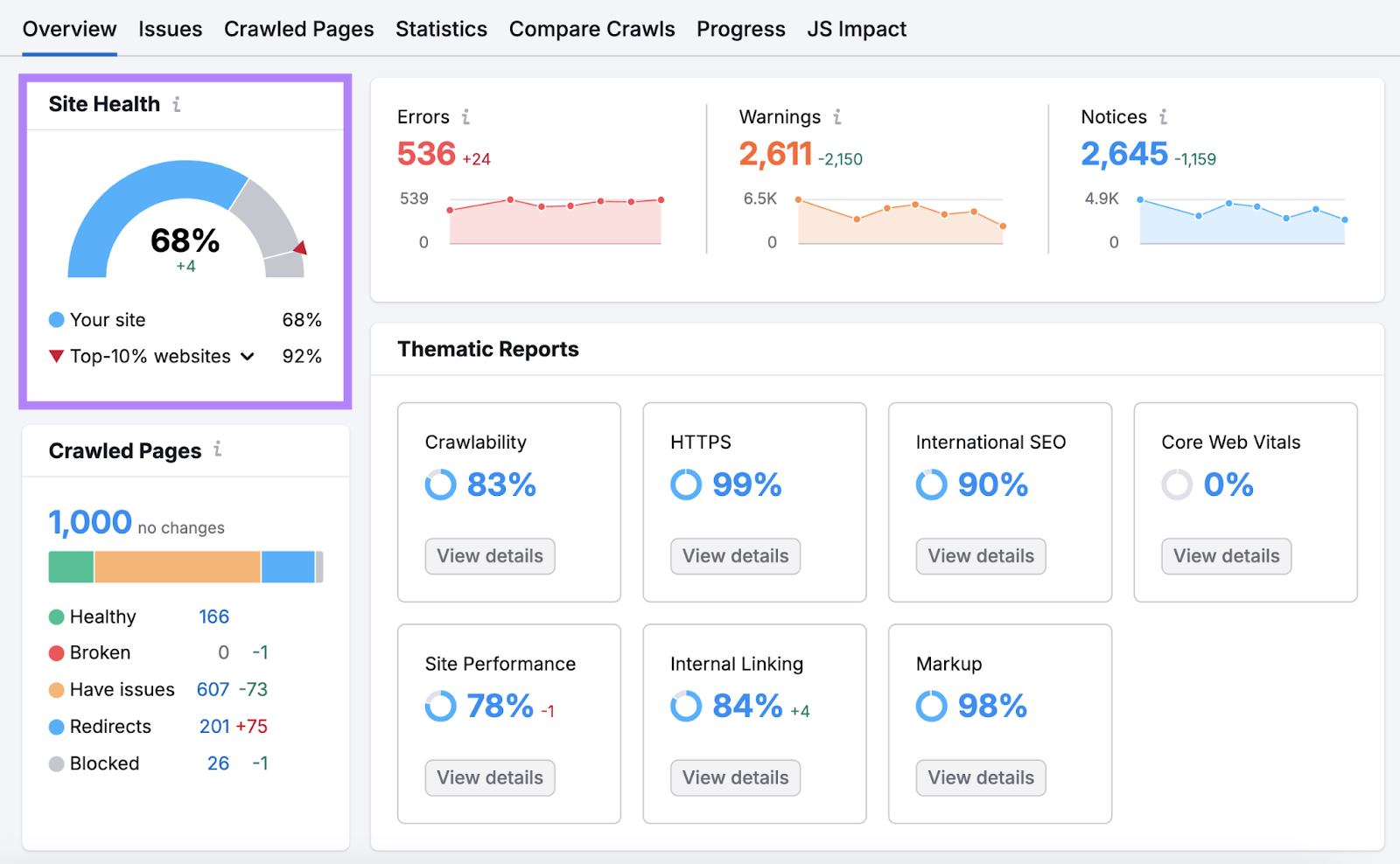
The audit categorizes your site issues by severity into “Errors,” “Warnings,” and “Notices.” For a more targeted approach, focus on specific areas of technical SEO using the Thematic Reports.
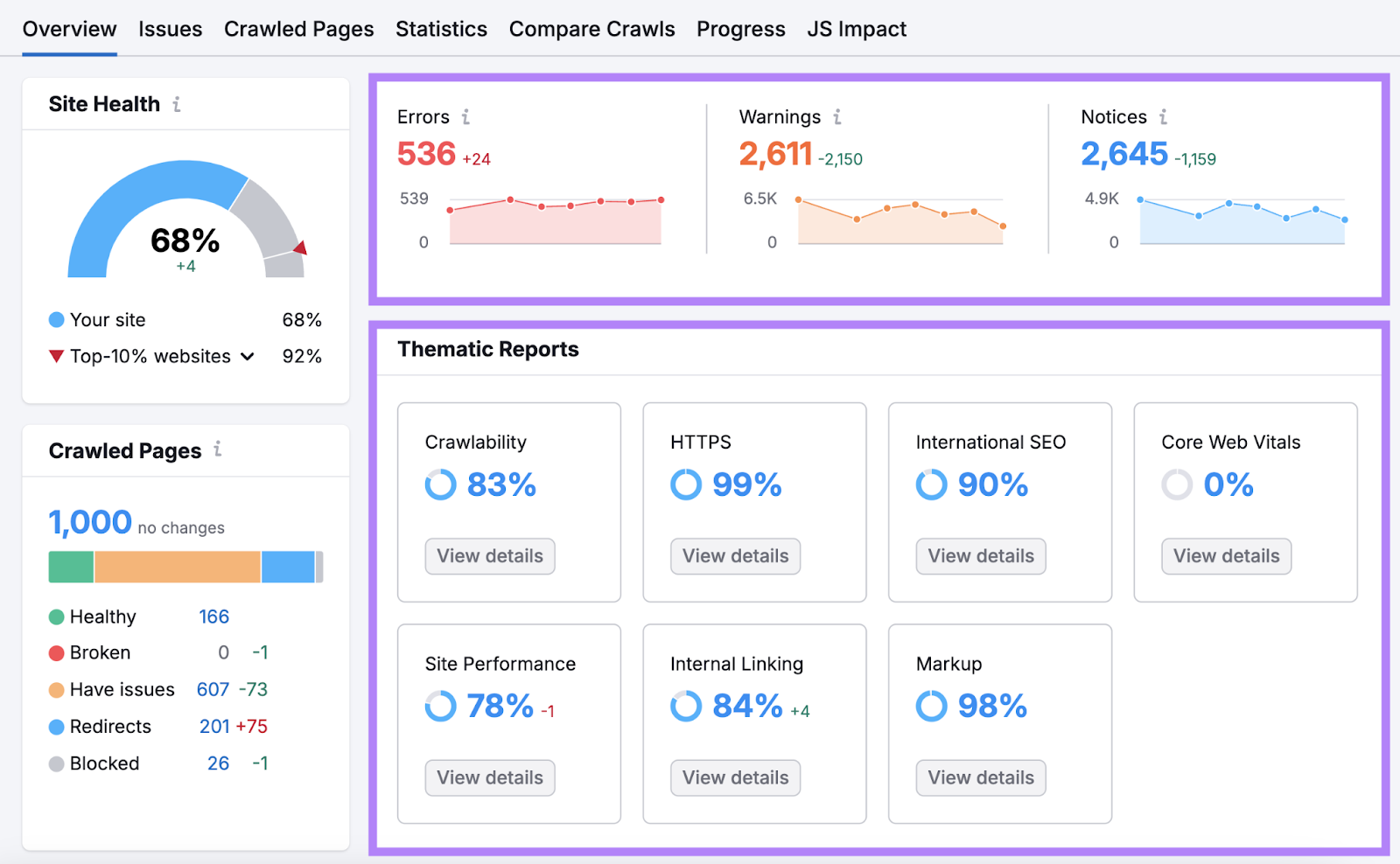
The “Issues” tab provides a complete breakdown of all detected issues and the number of affected pages, along with detailed “Why and how to fix it” guidance to help you resolve each problem.
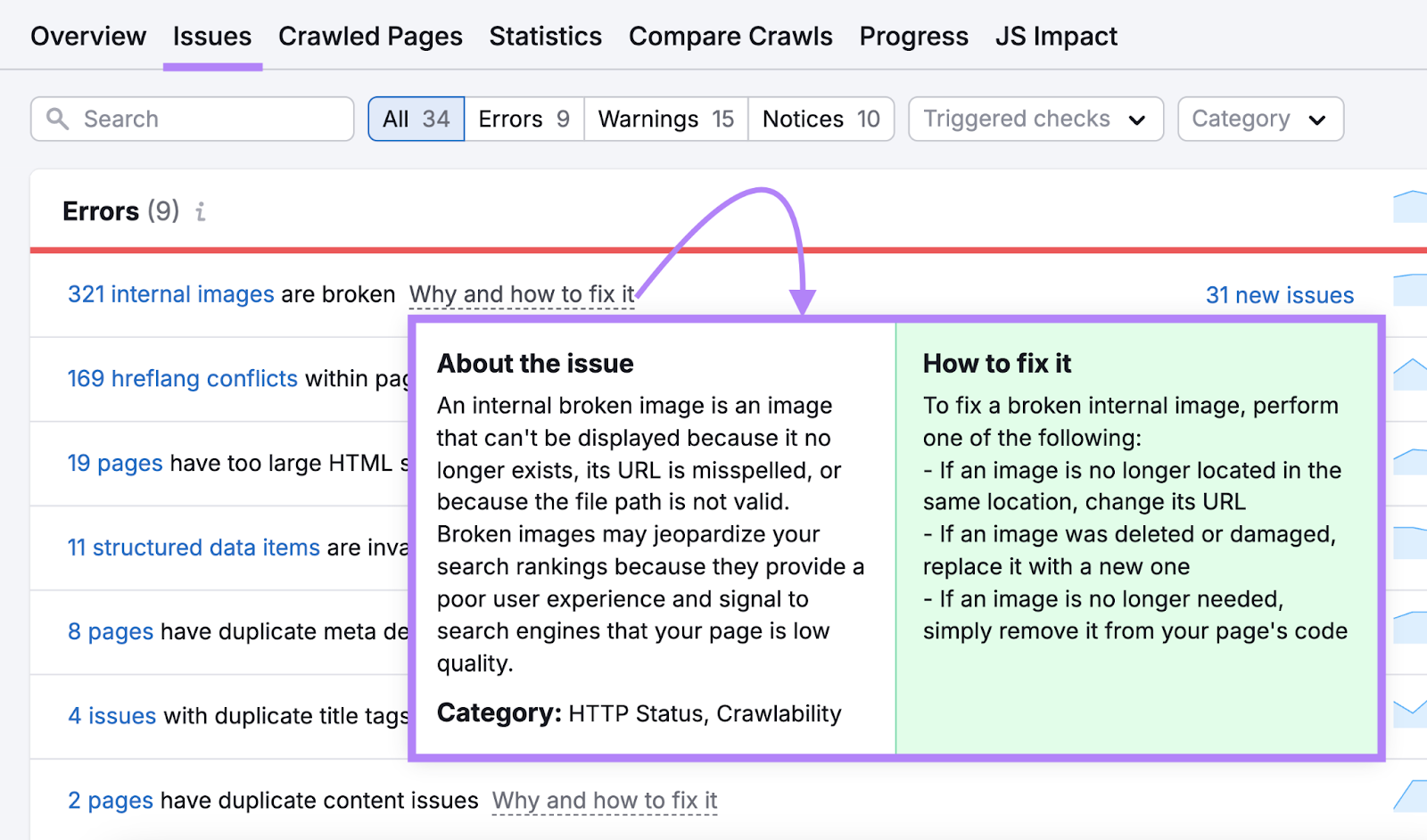
For a new site, it’s important to do a technical SEO audit right away to make sure your site has a solid technical foundation.
After that, you should check your site regularly—once a month if possible, or at least every three months—to catch and fix any problems before they start affecting your rankings.
Track the SEO Performance of Your Homepage
Monitoring the SEO performance of your homepage is crucial for understanding how well it meets your goals and aligns with user intent.
Semrush’s Position Tracking tool lets you monitor your homepage’s rankings for specific keywords over time.
The tool allows you to:
- Track your website's daily keyword rankings across search engines and devices
- Identify competitors targeting your keywords and compare their rankings, visibility, and traffic against yours
- Group keywords by topics, campaigns, or goals using tags to better organize your tracking and insights
- Access useful metrics like visibility, share of voice, estimated traffic, and ranking trends over time
Once you’ve set up keyword tracking, go to the “Overview” tab to view metrics for your tracked keywords.
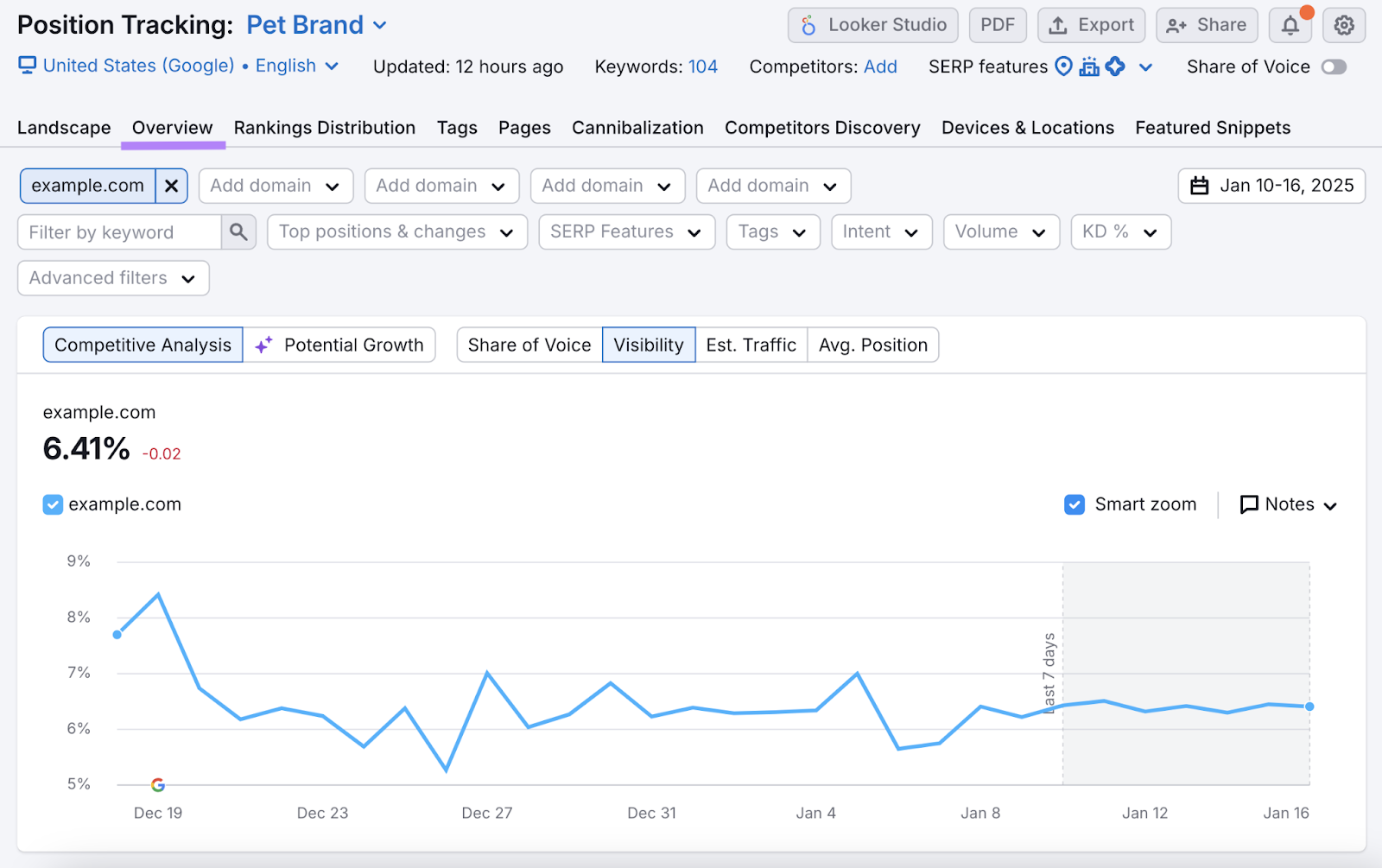
Scroll down to the “Rankings Overview” section, where you’ll find a list of your keywords, your current rankings for each one, and how your positions have changed over time.

Try the Position Tracking tool today to monitor your homepage’s keyword rankings.
